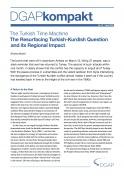The last eight months have seen a resumption of violent clashes in southeastern Turkey between Turkish security forces and Kurdish armed groups. While initial analysis suggested that a return to the peace process might be possible in the mid term, the current escalation in violence, rhetoric, and regional dynamics makes a quick fix highly unlikely. What many believe began as an extension of the election campaign of Turkey’s governing Justice and Development Party (AKP) has now turned into a situation that starkly resembles the dark days of Turkey’s civil war in the early 1990s.
At that time, as war raged through Turkey’s Kurdish-dominated areas, both the Kurdish resistance movement – the Kurdistan Workers’ Party (PKK) – and the Turkish state employed a strategy of repression and counter violence, both of which left the civilian population as the main victims. At least forty thousand people died, thousands were internally displaced through the Turkish state’s scorched-earth policy, and many people simply disappeared. Turkey’s current prime minister, Ahmet Davutoglu, evoked this time at an election rally last October, saying that it was his party, the AKP, that had managed to overcome the ominous era when “white Toros” were seen in the streets. (He was referring to the Renault 12s driven by the state’s infamous JITEM intelligence agency, which came to symbolize a state that killed and “disappeared” its own citizens.) It is also true, however, that it was the AKP’s hard-line nationalist policy that recently enlisted the state’s security apparatus to once again conduct an open war against the PKK.
The state had pursued negotiations with the PKK in different formats since 2009, and some advances were made on cultural rights such as the right to speak and teach Kurdish. Little progress was made on hard topics such as partial autonomy, however, and negotiations were marred by both a lack of formal structure and of a time line, as well as by the power asymmetries between the parties. The AKP had initially hoped to win Kurdish voters by promising reforms, economic investment, and partial autonomy. Relations deteriorated rapidly in late 2014, however, with the violent spillover of the Syrian war in the Syrian-Kurdish town of Kobani, which PKK and PYD fighters had successfully defended under US air cover against forces of the Islamic State (ISIS).
The peace process began to break down as the pro-Kurdish, leftist Peoples’ Democratic Party (HDP) abandoned its position to support the bid of President Recep Tayyip Erdogan to transform Turkey’s parliamentary system into a presidential one. A framework agreement (the Dolmabahce Agreement) signed in February 2015 as a last attempt by both sides to salvage the process was quickly disavowed by both the Turkish president and PKK hardliners. On June 11, 2015 the PKK announced an end to its ninth unilateral ceasefire, arguing that the government had used the lull in fighting to establish tighter security control in the region. On June 24, after a PKK-aligned group killed two police officers, the state started aerial bombardments against PKK positions in northern Iraq, where the PKK has its military headquarters in the Qandil mountain ridge. The PKK mobilized its armed youth wing, the Patriotic Revolutionary Youth Movement (YDG-H), which erected barricades and dug mined trenches in several Turkish cities in the southeast.
The AKP, driven by its will to win back the absolute majority that it had lost in the June parliamentary elections – due to the high turnout in support of the pro-Kurdish HDP (13 percent) – started a violent and ongoing campaign criminalizing HDP party leaders and supporters for their alleged links to the PKK. After early elections last November swept the AKP back into power with a single-party majority, the government vowed that it would never abandon the peace process, while at the same time intensifying the campaign of arrests and military violence against the PKK and its supporters.
The Ankara bombing of March 13, 2016 signals that the conflict is now coming to the western part of the country. The group that seems to be behind the attack claims it operates independently of the PKK, but the Turkish government nonetheless considers it a PKK subsidiary. This could escalate further. Certainly, both the government and the PKK now state that there is no going back to the peace process as it once was.
(Click on the pdf at the upper right to read the full text.)
